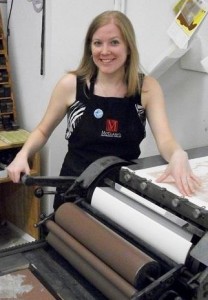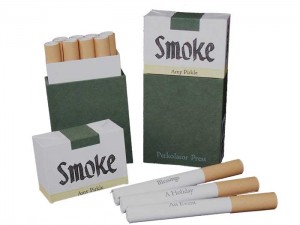Interview with: Amy Pirkle, Book Artist & University of Alabama Instructor in the Honors College, New College, and the Department of Art
How would you describe book arts to a layperson?
For me, book arts is a broad field that includes artist’s books, fine press books, fine bindings, and more. In all cases, though, I feel that an artist has made most of the design decisions and had a hand in the production of the book, from creating any artwork in the book, to printing the material using a variety of printmaking techniques, to binding the book by hand, and sometimes even making the paper as well. The book can either be a one-of-a-kind piece or part of a limited edition. The final product is a piece of art that is in book form. Of course, the definition of a book is pretty broad and can include all types of structures, from scrolls to accordions to sculptures and other unique bindings.
How did you first get involved in book arts?
When I was a junior in college (2001), I studied abroad with the University of Georgia program in Cortona, Italy. While I was there, I took an elective class in book arts taught by Eileen Wallace. I had never even heard of the field before; I was in Italy to study painting! But I read the course description and knew that it was a class I had to take. I realized when I was spending more time in the book studio making books than in my painting studio, that this was the thing I wanted to do for the rest of my life. When I got back to America, I finished up my undergraduate degree in art and began researching graduate programs. I found the University of Alabama’s M.F.A. in Book Arts program, and matriculated in 2004.
What’s your favorite book you’ve made – or do you have a favorite?
To be honest, each of my books is my favorite as I’m working on it. Right now, I’m really excited to be working on my current book, Eight Bedrooms, about the eight bedrooms my twin sister and I shared while growing up. But when I look back on the work I’ve made, I think I’m most proud of Smoke, Fragments, and A Real Fighting Man. [Editor’s note: view these items online at Perkolator Press.]
Can you tell us a bit about Smoke?
Sure! The book is about my maternal grandfather, who died from lung cancer in 1992 when I was 12 years old. It was a tough time for me, because he was the first person I had ever loved that passed. I wrote the text for this book in 2006 as a short story. The short story is broken into several shorter passages, each with its own title such as A Place, An Event, or An Early Memory, that represent different memories of my grandfather.
I spent two years playing with various book structures for the text, but nothing seemed to work. I’m a big believer in structure and content working hand in hand. One day, I realized that Smoke was not meant to be bound as a traditional book. Its true form was as a pack of Salem cigarettes, the preferred brand by my grandfather. Each of the shorter passages from the story was printed as a cigarette scroll. All cigarettes, including a colophon cigarette, were then cased together in a hand-crafted cigarette pack made of binder’s board with letterpress printed graphics.
How do you feel about having your books not just at Hoole, but also in libraries and special collections throughout the country?
I’m excited to be able to share my work with people at Hoole and across the country in other collections. One of the most humbling things I have stumbled on was about a year ago, when I found a YouTube video of a college student at Duke talking about Smoke for her book arts class. I think it’s great that other book arts instructors are taking their students into special collections libraries and showing them artist’s books. It generates excitement for a new generation of book artists.
What are some fellow book artists you’d recommend for readers who are new to the field of book arts?
One of my favorite book artists is Julie Chen. I think she is absolutely amazing, and she continues to push the boundaries of book arts with every new piece she publishes. Hoole has 2 of her books, including one of my favorites, a tunnel book called Octopus, which you can’t find on her website, but is in my opinion, the best tunnel book out there. [Editor’s note: You can see Octopus featured on Julie Chen’s Flying Fish Press page at Vamp & Tramp Booksellers.] Hoole also has You Are Here, a book she produced in 1992 that uses map imagery and map folds to create a truly unique reading experience.
Another book artist I would recommend is Karen Hanmer, who is a master at flag books. Hedi Kyle invented this structure in 1979, and some consider her one of the most influential artists on contemporary book arts (which she is!). But back to Hanmer, she has really explored this structure and created some truly fantastic pieces that show us what potential the flag book really has.
A newer book artist that I’m keeping my eye on is Michelle Ray. She’s incredible, and Hoole definitely has at least one of her books. Other book artists that I would recommend that graduated from The University of Alabama book arts program and would likely have work at Hoole are Inge Bruggeman, Sarah Bryant, and Ellen Knudson. I know all of these ladies personally, and they’re fantastic. [Editor’s note: Hoole has 2 books each by Inge Bruggeman and Ellen Knudson, but does not currently hold any works by Sarah Bryant.]
Smoke, by Amy Pirkle, is currently unavailable as it was loaned to the Hunter Museum of Art in Chattanooga, Tennessee for a spring 2014 exhibition on the book arts.
Pirkle’s work will be accompanied by books by Jenna Adams, Lynn Avadenka, Julie Chen, Nicole Eiland, Susan King, Ellen Knudson, Emily Martin, Coriander Reisbord , and the Combat Paper Project.
We are excited to see our collections travel! Once the exhibition is up at the Hunter, Cool@Hoole will be on the road to visit Smoke at its temporary home.


